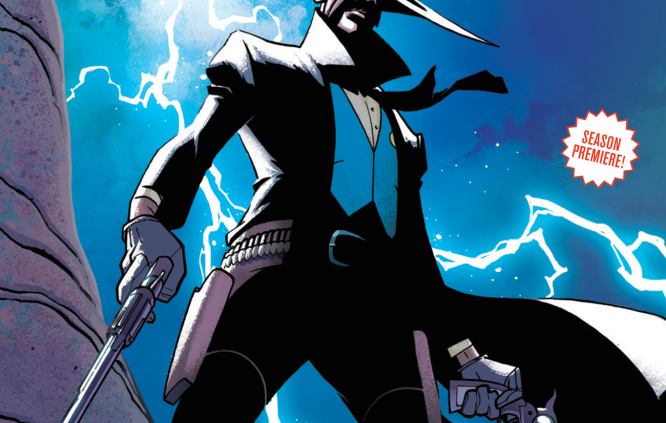When I first read through Bass Reeves #1, it didn’t really grab me. After reading it a second, third, and now fourth time, I’m not really sure what was wrong with my head before.
American Hero
If you’re like me, you’d never heard of Bass Reeves before hearing about this book. Turns out, “Old Bass” was a real man, rounding up over three thousand fugitives in his years of service to the U.S. Marshals. He was a man of faith and integrity, and his proven toughness gave him a somewhat mythical status in the minds of those who knew of him back in his time.
The Bass Reeves comic, from the fine folks at Allegiance Arts and Entertainment, begins with the events leading up to Bass’s recruitment into the Marshals. It’s written by Kevin Grevioux, illustrated by David Williams, colored by Kelsey Shannon, and lettered by Eric Weathers.
The setup
The story opens in 1875, in the so-called Indian Territory. When a gunfight leaves a Marshal dead, Judge Parker (of True Grit fame) pledges to stop losing good men to this dangerous endeavor. He says he needs a new kind of lawman.
We get to see what that “new kind of lawman” looks like, as Bass—still an independent “bounty man”—shows a group of bootleggers that the man is just as terrifying as the myth—even when that myth has exaggerated him into something almost supernatural.
The offer
And here’s where things get even more interesting. Bass and Parker connect, and when the latter offers the former a job as a Marshal, Bass refuses. He needs to be home with his family. His kids need their father. His wife needs her husband.
But when his son witnesses a brutal shootout, Bass recognizes the need—perhaps an obligation—for his skills as a tracker and manhunter to be put to use for a greater good. And so he joins.
Grevioux does a lot of things right in this book: the logical progression of events and decision-making, establishment of characters—Bass and Parker especially. But the thing he does best is giving Williams a chance to do his job.
We learn about Judge Parker as much from Williams as we do from the dialogue. The death of his Marshal on the first page has clearly taken a toll on him, which we see both in the teary, downcast face of Parker-as-comforter, and in the steely, resolute stare of Parker-as-avenger, determined to fight the lawlessness all around with a new breed of Marshal.
Williams’ talents continue to bear much fruit throughout, whether he’s making us feel the terror of the bootleggers, the lonesome sadness in Nel’ Reeves as her husband takes the Marshal’s oath, or the panic in the eyes of Bass himself, as he hears shots fired out on the street where his son stands, watching.
Williams has strong aesthetic chops, too. His characters are consistently-drawn, and while some features are a bit sharp and exaggerated, it’s never to the point that you stop taking the whole thing seriously. Bass’s story is that rare tall tale that draws on an equally tall reality, and Williams does an excellent job balancing that tension with his line work.
All of that line work is elevated by Shannon’s colors. There’s lots of subtlety in the rendering—a subtlety that often hides how rich and nuanced the colors are. And the book’s two campfire scenes are sold beautifully by Shannon, complementing Williams’s heavy ink without once undermining it. You’d be hard-pressed to find a comic book that looks better than this one.
Weathers does a fine job of lettering the book, with some solid aesthetic choices (love those open tails), and very readable balloon placement. Of course, he has plenty of help from Williams on that last point—the two work together quite well, with the panel layouts often providing a strong suggestion of the proper order. My favorite example is on the right.
The SFX range from decent to quite good—everything works, but some blend better with the surrounding artwork than others, to the point that I wondered whether or not Williams had drawn some of them (I’ve got an email out to Weathers to clarify—I’ll update here once I have a reply UPDATE: Weathers confirmed that some SFX were drawn by David Williams).
A new kind of lawman
In the end, what all of these creators do best is position Bass Reeves—both the man and his comic book—for a compelling future. When Bass asks his marks if they will be gathered like wheat, or burned like chaff, I believe: believe that he can take them, and that they believe he can take them. But I also believe that there’s more to Bass than hunting people down: that he cares for his wife and kids, even as he feels—and responds to—an obligation to serve the cause of justice with his talents. Old Bass is a character I want to follow to dozens more campfires, bootleggers, and other agents of lawlessness. He’s a character I want to follow into those weighty moments with his family. And Bass Reeves is a book I want to read as often, and as long, as it’s published.
source: https://www.comics-now.com/home/2020/4/14/bass-reeves-1-review




